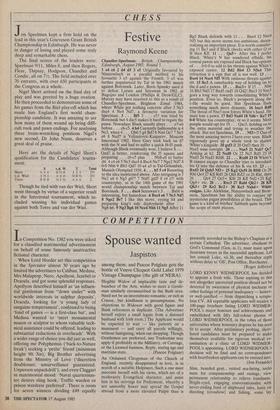CHESS
J on Speelman kept a firm hold on the lead in this year's Grieveson Grant British Championship in Edinburgh. He was never in danger of losing and played some truly deep and remarkable chess.
The final scores of the leaders were: Speelman 9/11, Miles 8, and then Rogers, Flear, Thipsay, Hodgson, Chandler and Condie, all on 71/2. The field included over 70 entrants, with over 650 participants in the Congress as a whole.
Nigel Short arrived on the final day of play and was greeted by a huge ovation. He then proceeded to demonstrate some of his games from the Biel play-off which has made him England's first world cham- pionship candidate. It was amazing to see how many of them wound up being diffi- cult rook and pawn endings. For analysing these brain-wrenching positions Nigel's new second, Dr John Nunn, deserves a great deal of praise.
Here are the details of Nigel Short's qualification for the Candidates' tourna- ment:
W T
Total
Short XXX 0 1/2 0
1 1 1
31/2 v.d. Wiel 1 1/2 1 x x
1/2 0 V2
31/2 Torre 0 0 0 1/2 1 1/2
XXX
2
Though he tied with van der Wiel, Short went through by virtue of a superior result in the Interzonal tournament, which in- cluded winning his individual games against both Torre and van der Wiel.
Festive
Raymond Keene
Chandler-Speelman: British Championship, Edinburgh, August 1985; Round 5.
1 e4 c6 2 d4 d5 3 e5 Originally favoured by Nimzowitsch as a parallel method to his favourite 3 e5 against the French, 3 e5 was further popularised by Tal in his 1961 match against Botvinnik. Later, Boris Spassky used it to defeat Larsen and Seirawan in 1982 at Bugojno and London (Phillips & DrewiGLC). Murray may have resorted to this as a result of Chandler-Speelman, Brighton Zonal 1984, where White got nothing concrete after 3 Nc3 dxe4 4 Ne4 Nd7, a favourite variation for Speelman. 3 . . . 11f5 3 . . c5? was tried by Botvinnik but 4 dxc5 makes it hard to regain the pawn. Nowadays Black usually plays . . . e7-e6 before . . . c6-c5.4 h4 Currently fashionable is 4 Nc3, when 4 . . . Qb6 5 g4 Bd7 6 Na4 Qc7 7 Nc5 e6 8 Nxd7 is Velimirovic-Kasparov, Moscow Interzonal 1982. Here Gary took back on d7 with the N and had to suffer a quick f4-f5 push. Although Black eventually won, I believe 8 . Qxd7 is better, reinforcing the f5 square and preparing . . c6-c5 plus . . . Nb8-c6 to batter d4. 4 c4 e6 5 Nc3 dxe4 6 Bxc4 Ne7 7 Nge2 Nd7 8 0-0 Nb6 9 Bb3 Qd7 10 a4 a5 is Ta1-Golombek, Munich Olympiad 1958. 4 . . . h5 5 c4 Resorting to the idea mentioned above. Also intriguing is 5 Ne2 e6 6 Ng3 g6I? 7 NxfS gxf5 8 c4 c5! with counterplay, as in the 14th game of the 1961 world championship match between Tal and Botvinnik. 5 . . . dxe4 Seirawan's 5 . . . Bxbl is interesting, but hazardous. 6 Bxc4 e6 7 Nc3 Nd7, 8 Nge2 Bel I like this move, eyeing h4 and preparing king's side deployment after . . Ng8-h6. 9 Ng3 Bg6 10 Nce4 Nh6 11 Ng5 After 11
Bg5 Black defends with 11 . . . Bxe4 12 Nxe4 Nf5 but this move seems too ambitious, decen- tralising an important piece. It is worth consider- ing 11 Be3 and if Black checks with either 0 or B then Kfl. 11 . . . QaS+ After this I prefer Black. White's N has wandered offside, his central pawns are exposed and Black has options of . . . 0-0-0 to add to his thrusts against White's exposed centre. 12 Bd2 BM 13 N5e4 This retraction is a sign that all is not well. 13 = • • Bxe4 14 Nxe4 Nf5 With ominous threats against d4. 15 Bc3 A ramshackle way of holding on to the d and e pawns. 15 . . Bxc3+ If 15 . . . Nb6 16 Bb3 Nd5 17 BxdS exd5 18 Qd2! Bxc3 19 Nxc3 goes a long way towards consolidating White's position. Even so, Black's prospects along the c-file would be good. But Speelman finds something much more dynamic. 16 bxc3 RdS The threat of Nxe5 now forces White's hand. He must lose a pawn. 17 Bd3 Nxd4 18 Nd6+ Ke7 19 0-0 White has counterplay, or so it seems. Most poeple would opt for 19 . . . Qxc3, holding on to the extra material and trying to weather the attack. But not Speelman. 19 . . . Nt3+11 One of the most amazing moves I have ever seen. Black vigorously gives up a whole rook to shatter White's kingside. 20 gxf3 If 20 Qxf3 then 20 . • Nxe5 wins outright. 20 . . . Nxe5 21 Nxb7 Qc7 Aiming at h2. 22 Nxd8 Or 22 Nc5 Rd5 23 f4 Nxd3 24 Nxd3 Rfd8. 22 . Rxd8 23 f4 White's B cannot escape so Chandler tries to introduce his Q into the defence of his K via h5. 23 . • • Rxd3 24 Qxh5 Nf3+ 25 Kg2 Qxf4 26 Rfdl Or 26 Rhl Qe4 27 Kfl Rd5 28 Qh8 Rd21 or 26 Rhl, then 26 . . Qe4 27 Qc5+ Kf6 28 Kfl Nd2+ 29 Kgl Qg4+ etc. 26 . . . Rxc3 27 Rabl Qh2+ 28 Kfl Qh3+ 29 Keg Rc2+ 30 Ke3 Nxh4+ White resigns. Like Alekhine, Nimzowitsch and Bron- stein, Speelman has the ability to conjure up mysterious pagan possibilities at the board. This game is a kind of witches' Sabbath quite beyond the scope of most players.














































 Previous page
Previous page